Vesak
Vesak (Pali: Vesākha, Sanskrit: Vaiśākha), also known as Buddha Jayanti,[3] Buddha Purnima and Buddha Day, is a holiday traditionally observed by Buddhists and some Hindus in South and Southeast Asia as well as Tibet and Mongolia.[4] The festival commemorates the birth, enlightenment (Buddhahood), and death (Parinirvāna) of Gautama Buddha in Theravada and Tibetan Buddhism.[5] In 2020, Vesak day falls on 7th May in India[6][7]
| Vesak | |
|---|---|
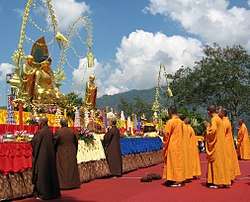 | |
| Official name | Vesak, Vesākha, Buddha Purnima, Buddha Jayanti, Vaisakha, Vaishakhi Purnima, Saka Dawa |
| Also called | Buddha's Birthday or Buddha Day |
| Observed by | Buddhists and some Hindus in South and Southeast Asia and in East Asia (as Buddha's Birthday) |
| Type | Religious |
| Significance | The birth, enlightenment and death (parinirvana) of Gautama Buddha |
| Observances | Meditation, observing the Eight Precepts, partaking of vegetarian food, giving to charity, "bathing" the Buddha |
| Date | Full moon of the month of Vesākha, usually in April (first), May or June (last) |
| 2019 date | 19 May |
| 2020 date | 6 May[1] 7 May (Sri Lanka)[2] |
| Frequency | Annual |
| Related to | Buddha's Birthday Other related festivals Laba Festival (in China) Rohatsu (in Japan) |
In the East Asian tradition, a celebration of Buddha's Birthday typically occurs around the traditional timing of Vesak. The Buddha's awakening and death are celebrated as separate holidays that occur at other times in the calendar as Bodhi Day and Nirvana Day.
History
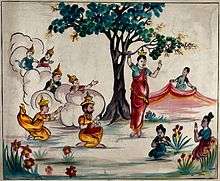
The decision to agree to celebrate Vesak as the Buddha's birthday was formalized at the first conference of the World Fellowship of Buddhists held in Sri Lanka in 1950, although festivals at this time in the Buddhist world are a centuries-old tradition. The resolution that was adopted at the World Conference reads as follows:
That this Conference of the World Fellowship of Buddhists, while recording its appreciation of the gracious act of His Majesty, the Maharaja of Nepal in making the full-moon day of Vesak a Public Holiday in Nepal, earnestly requests the Heads of Governments of all countries in which large or small number of Buddhists are to be found, to take steps to make the full-moon day in the month of May a Public Holiday in honour of the Buddha, who is universally acclaimed as one of the greatest benefactors of Humanity.[8]
On Vesak Day, Buddhists all over the world commemorate events of significance to Buddhists of all traditions: The birth, enlightenment and the passing away of Gautama Buddha. As Buddhism spread from India it was assimilated into many foreign cultures, and consequently Vesak is celebrated in many different ways all over the world. In India, Vaishakh Purnima day is also known as Buddha Jayanti day and has been traditionally accepted as Buddha's birth day.
In 2000, the United Nations (UN) resolved to internationally observe the day of Vesak at its headquarters and offices.[9]
The name of the observance is derived from the Pali term vesākha or Sanskrit vaiśākha, which is the name of the lunar month used in ancient India falling in April–May. In Mahayana Buddhist traditions, the holiday is known by its Sanskrit name (Vaiśākha) and derived variants of it. Local renditions of the name vary by language, including:
- Assamese: বুদ্ধ পূর্ণিমা Buddho Purnima
- Bengali: বুদ্ধ পূর্ণিমা Buddho Purnima, বুদ্ধ জয়ন্তী Buddho Joyonti
- Dzongkha: སྟོན་པའི་དུས་ཆེན་༥ འཛོམས་ Dhüchen Nga Zom
- Burmese: ကဆုန်လပြည့် ဗုဒ္ဓနေ့ "Full Moon Day of Kason"
- Mon: တ္ၚဲကျာ်ဗုဒ္ဓ ဗပေၚ်ပသာ် "Buddha Day Full Moon of Pasāk"
- Chinese: 佛陀誕辰紀念日; pinyin: Fótuó dànchén jìniàn rì, (Buddha's Birthday or Birthday of the Gautama Buddha), 佛誕 (Fódàn, Birthday of the Buddha), 浴佛節 (Yùfójié, Occasion of Bathing the Buddha), 衛塞節 (Wèisāi jié Vesak Day), 偉大的衛塞節花節偉大的滿月 (Wěidà de wèi sāi jié huā jié wěidà de mǎnyuè Great Vesak Day Flower Festival Full Moon of Flower Moon)
- Hindi: बुद्ध पूर्णिमा Buddha Pūrṇimā, बुद्ध जयन्ती Buddha Jayantī, वैशाख पूर्णिमा Vaisākh Pūrṇimā
- Indonesian: Hari Raya Waisak
- Japanese: 花祭り Hanamatsuri (Flower Festival)
- Khmer: វិសាខបូជា Visak Bochea
- Kannada: ಬುದ್ಧ ಪೌರ್ಣಮಿ Buddha Pournami
- Korean: 석가 탄신일; Hanja: 釋迦誕辰日; RR: Seokka Tanshin-il (Birthday of the Shakyamuni Buddha), Korean: 부처님오신날 (Buddha's Day)
- Lao: ວິສາຂະບູຊາ Vixakha Bouxa
- Malay: Hari Wesak (هاري ويسق)
- Mongolian: Бурхан Багшийн Их Дүйцэн Өдөр ᠪᠦᠷᠺᠬᠠᠨ
ᠪᠠᠭᠰᠬᠢᠢᠨ
ᠢᠺᠬ
ᠳᠦᠢᠲᠰᠡᠨ
ᠥᠳᠥᠷ Burkhan Bagshiin Ikh Düitsen Ödör (Lord Buddha's Great Festival Day) - Russian: День рождения Гаутамы Будды Den' rozhdeniya Gautamy Buddy (Birthday of the Gautama Buddha), Russian: День Гаутамы Будды (Den' Gautamy Buddy Gautama Buddha's Day), Russian: Великий День Цветов Весак (Velikiy Den' Tsvetov Vesak Great Vesak Flower Day), Russian: День Весака (Den' Vesaka Vesak Day), Russian: День Будды (Den' Buddy Buddha's Day), Russian: Буддийское рождество (Buddiyskoye rozhdestvo Buddhist Christmas)
- Marathi: बुद्ध पोर्णिमा Buddha Pornima
- Nepal Bhasa: स्वांया पुन्हि Swānyā Punhi
- Nepali: बुद्ध पुर्णिमा Buddha Purnima, बुद्ध जयन्ति Buddha Jayanti
- Odia: ବୁଦ୍ଧ ପୂର୍ଣ୍ଣିମା Buddha Purnimā
- Sinhala: වෙසක් Vesak
- Tamil: விசாகத் திருநாள் Vicākat Tirunāḷ
- Malayalam: വെസാക്കിന്റെ ബുദ്ധ ദിനം പസാക്കിന്റെ പൂർണ്ണചന്ദ്രൻ (vesākkinṟe bud'dha dinaṁ pasākkinṟe pūrṇṇacandran Great Buddha Day of Vesak Full Moon of Pasāk)
- Tagalog: Araw ng Waisak, Araw ni Buddha, Budistang Pasko (Vesak Day, Buddha Day, The Buddhist Christmas)
- Telugu: బుద్ధ పౌర్ణమి Buddha Pournami or alternatively వైశాఖ పౌర్ణమి Vaisakha Pournami
- Thai: วิสาขบูชา Wisakha Bucha
- Tibetan: ས་ག་ཟླ་བ་དུས་ཆེན, Wylie: sa ga zla ba dus chen, THL: Sa Ga Dawa Dü Chen
- Vietnamese: Phật Đản (佛誕) (Birthday of the Buddha), Vietnamese: Ngày hội hoa phật (佛诞节) (Buddha's Lord Flower Festival Day)
Celebration
The month of May usually has one full moon, but as there are 29.5 days between full moons, occasionally there are two. If there are two full moons during the month of May, some countries (including Sri Lanka, Cambodia and Malaysia) celebrate Vesak on the first full moon, while others (Thailand, Singapore) celebrate the holiday on the second full moon because of a different local lunar observance. The difference also manifests in the observance of other Buddhist holidays, which are traditionally observed at the local full moon.[10]
Likewise, in 2012, Vesak was observed on 28 April in Hong Kong and Taiwan, on 5 May in Sri Lanka, on 6 May in India and Bangladesh, on 28 May in South Korea, and on 4 June in Thailand. (In 1999, the Taiwanese government set Buddha's birthday as the second Sunday of May, the same date as Mother's Day.[11][12]). In 2014, Vesak is celebrated on 13 May in Myanmar, Singapore and Thailand while it is observed on 15 May in Indonesia.
On Vesak, devout Buddhists and followers alike assemble in their various temples before dawn for the ceremonial and honorable hoisting of the Buddhist flag and the singing of hymns in praise of the holy triple gem: The Buddha, The Dharma (his teachings), and The Sangha (his disciples). Devotees may bring simple offerings of flowers, candles and joss-sticks to lay at the feet of their teacher. These symbolic offerings are to remind followers that just as the beautiful flowers would wither away after a short while, and the candles and joss-sticks would soon burn out, so too is life subject to decay and destruction. Devotees are enjoined to make a special effort to refrain from killing of any kind. They are encouraged to partake only of vegetarian food for the day. In some countries, notably Sri Lanka, two days are set aside for the celebration of Vesak, and all liquor shops and slaughter houses are closed by government decree during the two days.
Also birds, insects and animals are released by the thousands in what is known as a 'symbolic act of liberation' of giving freedom to those who are in captivity, imprisoned, or tortured against their will. (The practice, however, is banned in some countries such as Singapore, as it is believed that the released animals are unable to survive long-term and may adversely impact the local ecosystem if they do.)[13]
Some devout Buddhists will wear simple white clothing and spend the whole day in temples with renewed determination to observe the eight precepts.
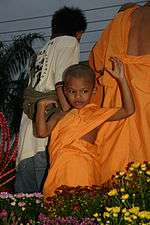
Devout Buddhists undertake to lead a noble life according to the teaching by making daily affirmations to observe the Five Precepts. However, on special days, notably new moon and full moon days, they observe the eight precepts to train themselves to practice morality, simplicity, and humility.
Some temples also display a small statue of the Buddha in front of the altar in a small basin decorated with flowers, and filled with water or sweet tea for devotees to pour over the statue. This is symbolic of the cleansing of a practitioner's bad karma, and to reenact the events following the Buddha's birth, when devas and spirits made heavenly offerings to him.
Devotees are expected to listen to talks given by monks. On this day, monks will recite verses uttered by the Buddha twenty-five centuries ago to invoke peace and happiness for the government and the people. Buddhists are reminded to live in harmony with people of other faiths and to respect the beliefs of other people as the Buddha taught.
Bringing happiness to others
Celebrating Vesak also means making special efforts to bring happiness to the unfortunate like the aged, the handicapped, and the sick. To this day, Buddhists will distribute gifts in the form of cash, or volunteering in various charitable homes throughout the country. Vesak is also a time for great joy and happiness, expressed not by pandering to one's appetites, but by concentrating on useful activities such as decorating and illuminating temples, or painting and creating exquisite scenes from the life of the Buddha for public dissemination. Devout Buddhists also vie with one another to provide refreshments and vegetarian food to followers who visit the temple to pay homage to the Enlightened One.
Paying homage to the Buddha
According to tradition the Buddha instructed followers how to pay him homage. Just before he died, he saw his faithful attendant Ananda, weeping. The Buddha advised him not to weep, instead to understand the universal law that all compounded things (including even his own body) must disintegrate. He advised everyone not to cry over the disintegration of the physical body but to regard his teachings (The Dharma) as their teacher from then on, because only the truth of the Dhamma is eternal, and not subject to the law of change. He also stressed that the way to pay homage to him was not merely by offering flowers, incense, and lights, but by truly and sincerely striving to follow his teachings.
Dates of observance
The exact date of Vesak is based on Asian lunisolar calendars and is primarily celebrated in Vaisakha, a month of both the Buddhist and Hindu calendars, hence the name Vesak. In Nepal, which is considered the birth-country of Buddha, it is celebrated on the full moon day of the Vaisakha month of the Hindu calendar, and is traditionally called Buddha Purnima, Purnima meaning the full moon day in Sanskrit. In Theravada countries following the Buddhist calendar, it falls on Uposatha Day, the full moon typically in the 5th or 6th lunar month.
Nowadays, in Sri Lanka, Nepal, India, Bangladesh and Malaysia, Vesak/Buddha Purnima is celebrated on the day of the first full moon in May in the Gregorian calendar.
For countries using the lunisolar calendar, the date for Vesak or Buddha's Birthday varies from year to year in the Gregorian calendar, but usually falls in April or May; in leap years it may be celebrated in June. In Bhutan it is celebrated on the 15th day of the fourth month of the Bhutanese lunar calendar. In Thailand, Laos, Singapore and Indonesia, Vesak is celebrated on the fourteenth or fifteenth day of the fourth month in the Chinese lunar calendar. In China, Korea and Vietnam, Buddha's Birthday is celebrated on the eighth day of the fourth month in the Chinese lunar calendar. In Japan, Buddha's Birthday is observed on the same date but in the Gregorian calendar, i.e. 8 April.
In the following table, year numbers in the range of 2500–2599 are BE (Buddhist Era).
| Year (CE) | Thailand[14] | Singapore[15] | Laos | Myanmar | Sri Lanka[16] | Cambodia[17] | Indonesia[18] | Nepal, Bangladesh & India[19][20][21] | China | Malaysia[22] | Vietnam[23] | Bhutan[24] |
| 2001 | 7 May 2544 | 7 May | 6 May 2545 | 7 May 2545 | 7 May 2545 | 7 May 2545 | 7 May | 30 May | 7 May | 6 June | ||
| 2002 | 26 May 2545 | 27 May | 26 May 2546 | 26 May 2546 | 26 April 2546 | 26 May 2546 | 26 May | 19 May | 26 May | 26 May | ||
| 2003 | 15 May 2546 | 15 May | 15 May 2547 | 15 May 2547 | 15 May 2547 | 16 May 2547 | 16 May | 8 May | 15 May | 15 May | ||
| 2004 | 2 June 2547 | 2 June | 3 May 2548 | 4 May 2548 | 3 May 2548 | 3 June 2548 | 3 May | 26 May | 3 May | 2 June | ||
| 2005 | 22 May 2548 | 23 May | 22 May 2549 | 23 May 2549 | 22 May 2549 | 24 May 2549 | 23 May | 15 May | 22 May | 22 May | ||
| 2006 | 12 May 2549 | 12 May | 11 May 2550 | 12 May 2550 | 12 May 2550 | 13 May 2550 | 13 May | 5 May | 12 May | 12 May | ||
| 2007 | 31 May 2550 | 31 May | 31 May 2550 | 30 April 2551 | 1 May 2551 | 1 May 2551 | 1 June 2551 | 2 May | 24 May | 31 May | 31 May | |
| 2008 | 19 May 2551 | 19 May | 18 May 2551 | 19 May 2552 | 19 May 2552 | 19 May 2552 | 20 May 2552 | 20 May | 12 May | 19 May | 19 May | |
| 2009 | 8 May 2552 | 9 May | 8 May 2552 | 8 May 2553 | 8 May 2553 | 8 May 2553 | 9 May 2553 | 8 May | 2 May | 9 May | 9 May | |
| 2010 | 28 May 2553 | 28 May | 28 May 2553 | 27 April 2554 | 27 May 2554 | 28 April 2554 | 28 May 2554 | 27 May | 21 May | 28 May | 28 May | |
| 2011 | 17 May 2554 | 17 May | 17 May 2554 | 17 May 2555 | 17 May 2555 | 17 May 2555 | 17 May 2555 | 17 May | 10 May | 17 May | 17 May | |
| 2012 | 4 June 2555 | 5 May | 5 May 2555 | 5 May 2556 | 5 May 2556 | 5 May 2556 | 6 May 2556 | 6 May | 28 April | 5 May | 5 May | |
| 2013 | 24 May 2556 | 24 May | 24 May 2556 | 24 May 2557 | 24 May 2557 | 24 May 2557 | 25 May 2557 | 25 May | 24 May | 24 May | 24 May | |
| 2014 | 13 May 2557 | 13 May | 13 May 2557 | 13 May 2558 | 14 May 2558 | 13 May 2558 | 15 May 2558 | 14 May | 13 May | 13 May | 13 May | |
| 2015 | 1 June 2558 | 1 June | 2 May 2558 | 2 May 2559 | 3 May 2559 | 3 May 2559 | 2 June 2559 | 4 May | 25 May | 3 May | 1 June | |
| 2016 | 20 May 2559 | 21 May | 21 May 2560 | 21 May 2560 | 21 May 2560 | 22 May 2560 | 21 May | 14 May | 21 May | 14 May | 21 June | |
| 2017 | 10 May 2560 | 10 May | 10 May 2561 | 10 May 2561 | 10 May 2561 | 11 May 2561 | 10 May | 3 May | 10 May | 10 May | 21 June | |
| 2018 | 29 May 2561 | 29 May | 29 April 2562 | 29 April 2562 | 29 April 2562 | 29 May 2562 | 22 May | 22 May | 29 May | 29 May | 29 May | |
| 2019 | 18 May 2562 | 19 May | 18 May 2563 | 18 May 2563 | 18 May 2563 | 19 May 2563 | 18 May | 12 May | 19 May | 19 May | 17 June | |
| 2020 | 6 May 2563 | 7 May | 6 May 2564 | 7 May 2564 | 6 May 2564 | 7 May 2564 | 7 May | 30 April | 7 May | 6 June | 5 June | |
| 2021 | 19 May |
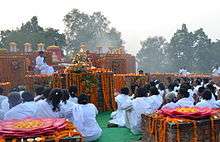
In Southeast Asia
In Laos
The Vixakha Bouxa festival is the Lao version of the Thai Visakha Puja, which it closely resembles. It commemorates the birth, enlightenment, and death of the Buddha, which are all said to have happened on the same date. It is held around the month of May or Vesak, based on the lunar calendar. Celebrations include dances, poems, parades, processions, deep meditation, theatrical performances, and puppet shows.
Boun Bang Fay
One part of the Vixakha Bouxa festival is called Boun Bang Fay, or Rocket Festival. As this occurs during the hottest and driest season of the year, large homemade rockets are launched into the sky in an attempt to convince the celestial beings to send down rain. Traditionally, Buddhist monks made the rockets out of hollow bamboo tubes filled with gunpowder (among other things). Nowadays, lay people make the bang fai more like fireworks and hold competitions for the highest, fastest and most colorful rockets. The event takes place on both sides of the Mekhong River border between Thailand and the Lao People's Democratic Republic, and sometimes teams from the neighbouring countries will compete against each other. Tourists travel long distances to witness this now popular event.
In Indonesia
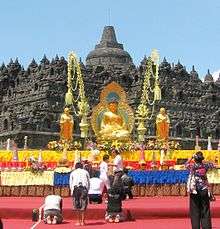
This significant and traditional holy day is observed throughout Indonesia, where it is known as Waisak Day.[25][26] At Borobudur, thousands of Buddhist monks will join together to repeat mantras and meditate as they circuit the temple in a ritual called "Pradaksina". This is a form of tribute to the temple. Monks celebrate the special day by bottling holy water (which symbolises humility) and transporting flames (which symbolize light and enlightenment) from location to location. The monks also take part in the "Pindapata" ritual, where they receive charity from the people of Indonesia. Waisak Day in Indonesia has been celebrated as a national public holiday every year since 1983.
In Malaysia
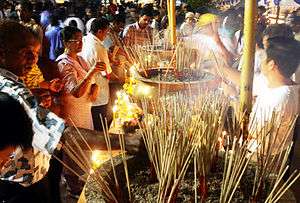
Celebrated by Buddhists to mark three momentous events in Buddha's life – his birth, enlightenment, and his departure from the human world, the Wesak celebration in Malaysia begins at dawn when devotees gather at Buddhist temples nationwide to meditate on the Eight Precepts. Donations – giving food to the needy and offerings of incense and joss sticks – and prayers are carried out. The sutras are chanted in unison by monks in saffron robes. The celebration is highlighted by a candle procession. Wesak Day in Malaysia is a national public holiday.
In Myanmar (Burma)
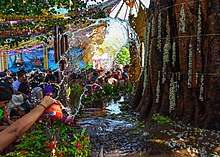
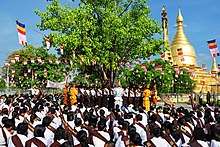
In Myanmar (Burma), Vesak is known as the Full Moon Day of Kason (ကဆုန်လပြည့် ဗုဒ္ဓနေ့), which is the second month in the traditional Burmese calendar.[27] The date is a public gazetted holiday. Buddhist devotees typically celebrate by offering alms to Buddhist monks, adhering to a more stringent set of Buddhist precepts, practicing meditation, and freeing fish and birds from captivity.[28]
Throughout the country, the date is also marked by a traditional festival called the Nyaungye-thun or "Bodhi tree water pouring festival" (ညောင်ရေသွန်းပွဲ), whereby devotees visit pagodas or monasteries (kyaung) to pour scented water to sacred Bodhi Trees using clay pots,[29] to ensure the trees, which hold great significance in Buddhism, do not die during the peak of summer.[28][30][31]
This tradition dates back to the pre-colonial era and continues to take place at major pagodas such as the Shwekyetyet and Shwekyetkya Pagodas in the former royal capital of Amarapura.[27] A Konbaung era court poet, Letwe Thondara composed a complete set of yadu poems describing this festival in Meza Hill, near Katha, where he had been exiled by King Hsinbyushin.[27]
In Singapore
In Singapore, Vesak Day was made a public holiday in 1955 after many public petitions, replacing Whit Monday.[32][33][34] In the early decades of the 20th century, Vesak Day was associated with the Ceylonese community which then celebrated it along with their National Day in a two-day event. After World War II, there was a movement to make Vesak Day a public holiday, with the Singapore Buddhist Association leading the petitions.[35]
In South Asia
In Bangladesh
Vesak Day is an important festival for most Bengali Buddhists. In Bangladesh, it is celebrated in Chittagong, Dhaka, and other Buddhist regions in the country. In the Bangla language, it is known as Buddho Purnima. It is also a public holiday in Bangladesh.
In Nepal
Vesak, commonly known in Nepal as "Buddha Jayanti" is widely celebrated all across the country, predominantly, Lumbini – the birthplace of Buddha, and Swayambhu – the holy temple for Buddhists, also known as "the Monkey Temple". The main door of Swayambhu is opened only on this very day, therefore, people from all over Kathmandu valley are stimulated by the event. Thousands of pilgrims from various parts of the world come together to celebrate Buddha's birthday at his birthplace, Lumbini. In Nepal, Buddha is worshipped by all religious groups, therefore "Buddha Jayanti" is marked by a public holiday. People donate foods and clothes to the needy and also provide financial aid to monasteries and schools where Buddhism is taught and practised.
In Sri Lanka

Vesak is celebrated as a religious and a cultural festival in Sri Lanka on the full moon of the lunar month of Vesak (usually in the Gregorian month of May), for about one week, and this festival is often celebrated by people of different religions in Sri Lanka.[36] During this week, the selling of alcohol and fresh meat is usually prohibited, with slaughter houses also being closed.[37] Celebrations include religious and alms-giving activities. Electrically-lit pandals called thoranas are erected in locations mainly in Colombo, Kandy, Galle and elsewhere, most sponsored by donors, religious societies and welfare groups. Each pandal illustrates a story from the Jataka tales.
In addition, colourful lanterns called Vesak kuudu are hung along streets and in front of homes. They signify the light of the Buddha, Dharma and the Sangha. Food stalls set up by Buddhist devotees called dansälas provide free food, ice-cream and drinks to passersby.[38] Groups of people from community organisations, businesses and government departments sing bhakti gee (Buddhist devotional songs). Colombo experiences a massive influx of people from all parts of the country during this week.
In East Asia
In Japan
In Japan, Vesak or hanamatsuri (花祭) is also known as Kanbutsue (灌仏会), Goutan'e (降誕会)), Busshoue (仏生会), Yokubutsue (浴仏会), Ryuge'e (龍華会) and Hanaeshiki (花会式). It is not a public holiday. It is based on a legend that nine dragons appeared in the sky on the Buddha's birthday and poured amṛta over him.[39]
It used to be celebrated on the 8th day of the fourth month in the Chinese calendar based on one of the legends that proclaims the day as Buddha's birthday. At present, the celebration is observed on 8 April of the Solar Calendar since the government of Meiji Japan adopted the western solar calendar as the official calendar. Since the 8th day of the fourth month in the lunar calendar commonly falls in May of the current solar calendar, it is now celebrated about a month earlier.
In Japan, Vesak celebrations include pouring 甘茶 (amacha), a sweet tea made from Hydrangea macrophylla, on statues. In Buddhist religious sites such as temples and viharas, more involved ceremonies are conducted for lay Buddhists, priests, and monks and nuns.
In South Korea
.jpg)
In South Korea the birthday of Buddha is celebrated on the 8th day of the 4th month in the Korean lunar calendar (as well as in Hong Kong, Macau, Vietnam) and is an official holiday. This day is called 석가탄신일 (Seokga tansinil), meaning "Buddha's birthday" or 부처님 오신 날 (Bucheonim osin nal) meaning "the day when the Buddha came". It has now grown into one of the nation's biggest cultural festivals. Lotus lanterns cover the entire temple throughout the month which are often flooded down the street.[40] On the day of Buddha's birth, many temples provide free meals and tea to all visitors. The breakfast and lunch provided are often sanchae bibimbap.
In Vietnam
Before 1975, the birthday of Buddha was a national public holiday in South Vietnam.[41] It was a public festival with floats, and lantern parades on the streets. However, after the Fall of Saigon, the day was no longer a public holiday. Since the 2000s, the festival has witnessed a revival across the country, as the country's communist regime sought to side with Buddhism in fear of accusation of religious persecution by the Christian minority.[42]. The Vesak Celebration is officially held by the Vietnamese Buddhist Sangha every year and it aggregated international delegates for great events in 2008, 2014, 2019 (the 16th United Nations Day of Vesak Celebration).[43].
At the United Nations
In 1999, the United Nations General Assembly adopted resolution 54/115, entitled 'International recognition of the Day of Vesak at United Nations Headquarters and other United Nations offices'. The resolution internationally recognized the Day of Vesak to acknowledge the contributions that Lord Buddha and Buddhism have made for over two and a half millennia. It also called for annual commemoration of the day at the UN Headquarters, in New York, and other UN offices around the world.[44][45]
The Day of Vesak is an official holiday for the UN offices in many of the countries in South-East Asia.
See also
References
- Splendid Moons.
- https://publicholidays.lk/2020-dates/. Missing or empty
|title=(help) - "BBC on Buddhism". BBC Religions. BBC. Retrieved 21 November 2018.
- Fowler, Jeaneane D. (1997). World Religions: it is celebrated to mark the birth, enlightenment and the passing away of the Lord Buddha. An Introduction for Students. Sussex Academic Press. ISBN 1-898723-48-6.
- "Visakha Puja". Accesstoinsight.org. Retrieved 20 March 2012.
- "Vesak Day 2020". SA News Channel.
- "When is Buddha Jayanti 2020?". Times Now News.
- "World Fellowship of Buddhists Second Two-Year Plan (B.E. 2544-2545/2001-2002)". Buddha Dhyana Dana Review Online. Retrieved 25 December 2015.
- "Resolution Adopted by the General Assembly: 54/115. International recognition of the Day of Vesak at United Nations Headquarters and other United Nations offices" (PDF). United Nations. Retrieved 6 February 2012.
- "Vesak festival: What is it and how do Buddhists celebrate Buddha Day or Wesak?". BBC.
- Camaron Kao (14 May 2012), "Thousands of believers mark Buddha's birthday", China Post, archived from the original on 16 June 2013
- Ko Shu-Ling (9 May 2011), "Sakyamuni Buddha birthday celebrated", Taipei Times,
The legislature approved a proposal in 1999 to designate the birthday of Sakyamuni Buddha – which falls on the eighth day of the fourth month of the lunar calendar – a national holiday and to celebrate the special occasion concurrently with International Mother's Day, which is celebrated on the second Sunday of May.
- "Vesak Day practice of releasing animals harms ecosystems". 22 May 2016.
- "International VisakhaBuja Date Collection". เมื่อนานาประเทศ ต่างหันหลังให้ (วันวิสาขบูชา) ไทย. Retrieved 2 February 2012.
- "Vesak Day in Singapore". timeanddate.com. Retrieved 1 March 2019.
select pull-down menu to see more years
- "Vesak Full Moon Poya Day in Sri Lanka". timeanddate.com. Retrieved 1 March 2019.
- "Visak Bochea Day in Cambodia". timeanddate.com. Retrieved 1 March 2019.
select pull-down menu to see more years
- "Waisak Day (Buddha's Anniversary) in Indonesia". timeanddate.com. Retrieved 1 March 2019.
- "Buddha Jayanti in Nepal". timeanddate.com. Retrieved 1 March 2019.
- "Buddha Purnima/Vesak in Bangladesh". timeanddate.com. Retrieved 1 March 2019.
- "Buddha Purnima/Vesak in India". timeanddate.com. Retrieved 1 March 2019.
- "Wesak Day in Malaysia". timeanddate.com. Retrieved 1 March 2019.
- "Âm lịch VN". www.informatik.uni-leipzig.de.
- "Buddha's Parinirvana in Bhutan". timeanddate.com. Retrieved 1 March 2019.
- Akhtar Malik (1 January 2007). Survey of Buddhist Temples and Monasteries. Anmol Publications. p. 145. ISBN 978-81-261-3259-1.
- Sameer Das Gupta (1 January 2008). Advanced history of Buddhism: monasteries and temples. Cyber Tech Publications. p. 145.
- Khin Maung Nyunt (18 May 2019). "Full moon day of Kasone: Buddha Day". The Global New Light of Myanmar.
- "Full moon day of Kason". The Myanmar Times. 20 May 2016. Retrieved 24 May 2020.
- "Stay at home day of Kasone". The Myanmar Times. 5 May 2020. Retrieved 24 May 2020.
- "Full moon day of Kason". Yangon Life. Retrieved 24 May 2020.
- Ye Ye Myint (19 May 2019). "Buddha Day, Full Moon Day of Kason celebrated across Myanmar". Myanmar News Agency.
- Y. D. Ong (1 January 2005). Buddhism in Singapore: A Short Narrative History. Skylark Publications. p. 206. ISBN 978-981-05-2740-2.
- Piyasīlo (1992). New Directions in Buddhism Today: Celebrating 30 Years of the Buddha Day Holidays, 1962-1992. Community of Dharmafarers. p. 6. ISBN 978-983-9030-03-7.
- Jason Lim; Terence Lee (26 May 2016). Singapore: Negotiating State and Society, 1965-2015. Routledge. p. 147. ISBN 978-1-317-33152-0.
- migration (12 May 2014). "Vesak Day: 5 things you should know about this Buddhist celebration".
- "Unifying the Spiritual and The secular". Sunday Observer. 27 April 2018. Retrieved 29 April 2018.
- Vesak Festival in Sri Lanka
- "Vesak Festival in Sri Lanka". lanka.com. Retrieved 29 April 2018.
- 「年中行事事典」p242 1958年(昭和33年)5月23日初版発行 西角井正慶編 東京堂出版
- "Lotus lanterns light up Seoul night".
- Niên biểu lịch sử Phật giáo Việt Nam Archived 15 November 2012 at the Wayback Machine
- https://vietnamnews.vn/society/518892/ha-nam-province-to-host-vesak-2019.html
- http://www.undv2019vietnam.com/en
- United Nations News Service (10 May 2017). "Buddha's message of compassion 'timeless' says UN chief on international day". UN News Service Section. United Nations. UN News Centre. Retrieved 11 May 2017.
- "International recognition of the Day of Vesak at United Nations Headquarters and other United Nations offices". www.un.org. United Nations. Retrieved 11 May 2017.

